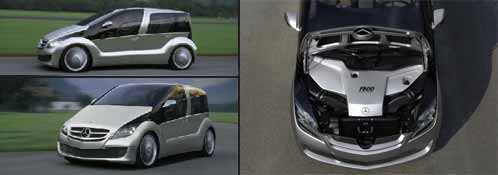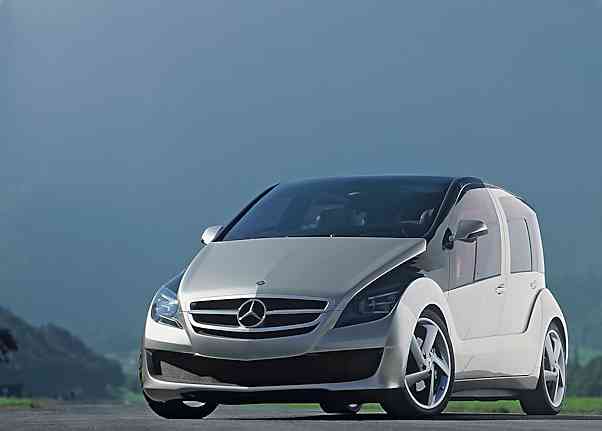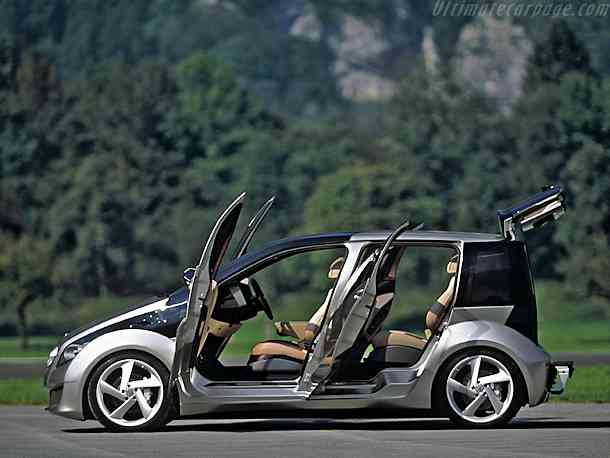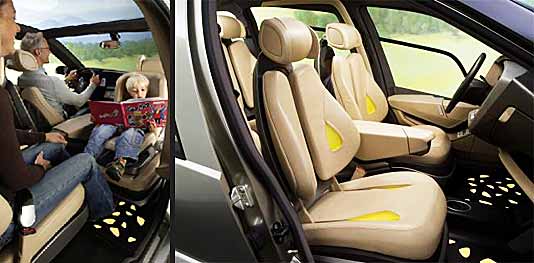Mercedes Benz F600 Hygenius
DaimlerChrysler Mercedes F600 Hygenius Hydrogen Concept CarThe DaimlerChrysler Mercedes F600 Hygenius provides genius when it comes to modern design and hydrogen car functionality. In regards to design there is nothing like it currently on the market or in the concept arena. In regards to hydrogen car functionality, the F600 Hygenius offers many standard H2 features plus some other advanced features.
The DaimlerChrysler Mercedes F600 Hygenius comes equipped with a 240v outlet, which, according to Mercedes can make the Hygenius a mobile power source able to power two houses or supply juice to a recreational vehicle with its 66 kW output. Mercedes has stopped short on discussing the potential for vehicle to grid applications. Surplus energy for the Hygenius is stored in a powerful lithium-ion battery pack and then delivered as needed to the electric motor making the Hygenius very similar to a hybrid vehicle in this regard. Under low speeds, for maneuvering and parking the Hygenius will run on its battery pack alone. Upon acceleration, the Hygenius will use both its battery and fuel cell in unison for maximum power output. Regenerative braking helps recapture energy and restore power to the battery pack. The F600 Hygenius delivers 115 hp, a peak torque of 350 Nm and has a range of 250 miles.
In addition, because this is a Mercedes, the F600 Hygenius offers standard features such as built in cameras that warn drivers if other vehicles are in their blind spots, heated and chilled cup holders and a Pre-Safe system, which protects passengers when an upcoming accident is detected. When parked, if the built-in cameras detect an oncoming bicycle or car approaching from behind, the Hygenius will temporarily disable the doors so that a collision will be avoided. When driving, the cameras monitor vehicles in the Hygenius’ blind spot and will warn the driver who is about to change lanes of their presence.
Besides being a technological showpiece, the F600 Hygenius was designed with the family in mind as well. The ISOFIX child seats can be locked into place and the backrests swung around in a face-to-face arrangement and young children can be easily attended to with this new seat configuration. In addition, the two-piece tailgate opens with minimal arc space making it easy to load and unload from the rear. The driver’s seat also features a two-piece backrest cushion that follows the upper body movements and minimizes the strain on the vertebra, regardless of the seat position.
According to Dr. Thomas Weber, DaimlerChrysler AG Board Member for Research & Technology and Head of Development at the Mercedes Car Group, “This represents a major step towards bringing the fuel cell drive up to full production maturity, a goal that we aim to achieve some time between 2012 and 2015. By developing the fuel cell, we are creating a new basis for supplying energy in tomorrow’s vehicles which will make a further lasting improvement to their environmental compatibility.” In addition, Professor Herbert Kohler, Director of Vehicle Body and Drive Research at DaimlerChrysler says of the F600 Hygenius, “We have made some crucial advances to this trailblazing technology. The fuel cell in the F 600 HYGENIUS is around 40 per cent more compact than previously, runs more efficiently than ever and is notable for its good cold-start characteristics. This has been achieved thanks to the inclusion of innovations such as the redesigned fuel stacks, an electric turbocharger and a new humidification and dehumidification system.” With the first production H2 fuel cell car being 3 or so years away, its hard to think how Mercedes will be able to top the genius of Hygenius. But, 7 years is a long time and if the F600 Hygenius is any indication the Mercedes engineers may just be able to come up with a vehicle to make George Jetson a little envious.
Written by Hydro Kevin Kantola
|
Leave a Reply
You must be logged in to post a comment.



